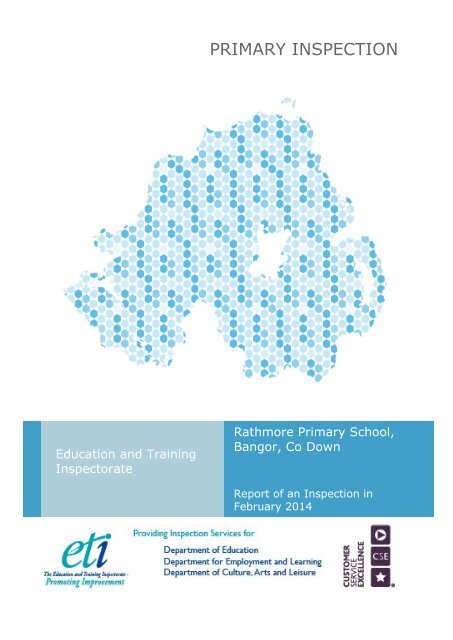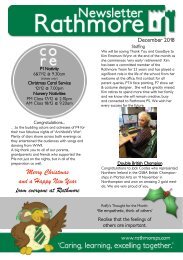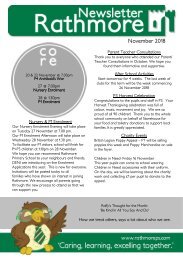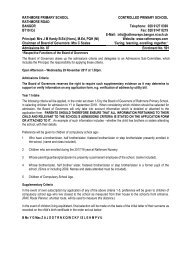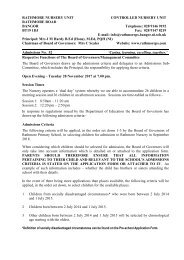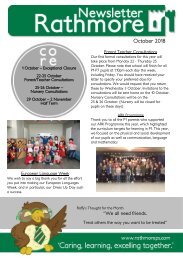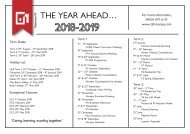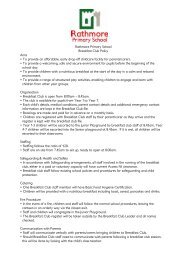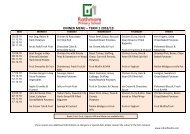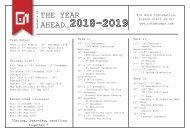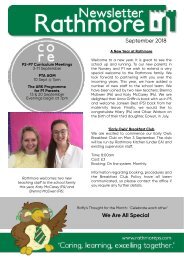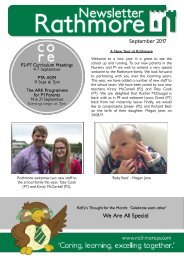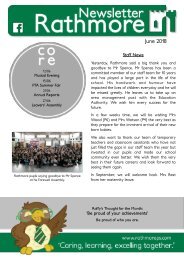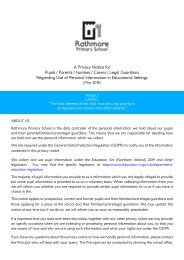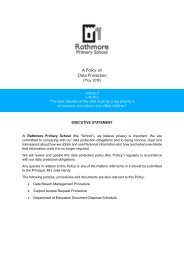ETI Report, Rathmore Primary School, 2014
Our latest inspection report (February 2014).
Our latest inspection report (February 2014).
Create successful ePaper yourself
Turn your PDF publications into a flip-book with our unique Google optimized e-Paper software.
PRIMARY INSPECTION<br />
Education and Training<br />
Inspectorate<br />
<strong>Rathmore</strong> <strong>Primary</strong> <strong>School</strong>,<br />
Bangor, Co Down<br />
<strong>Report</strong> of an Inspection in<br />
February <strong>2014</strong>
Quantitative terms<br />
In this report, proportions may be described as percentages, common fractions and in more<br />
general quantitative terms. Where more general terms are used, they should be interpreted<br />
as follows:<br />
Almost/nearly all - more than 90%<br />
Most - 75%-90%<br />
A majority - 50%-74%<br />
A significant minority - 30%-49%<br />
A minority - 10%-29%<br />
Very few/a small number - less than 10%<br />
Performance levels<br />
The Education and Training Inspectorate (<strong>ETI</strong>) use the following performance levels in<br />
reports:<br />
DESCRIPTOR<br />
Outstanding<br />
Very Good<br />
Good<br />
Satisfactory<br />
Inadequate<br />
Unsatisfactory
Contents<br />
Section<br />
Page<br />
1. Inspection method and evidence base 1<br />
2. Context 1<br />
3. Focus of inspection 2<br />
4. Overall finding 2<br />
5. Achievements and standards 2<br />
6. Provision 3<br />
7. Leadership and management 5<br />
8. Conclusion 6<br />
Appendix
1. Inspection method and evidence base<br />
The key questions and quality indicators which guide inspection and self-evaluation of<br />
primary schools, which were applied to this inspection, are available in the Education and<br />
Training Inspectorate’s (<strong>ETI</strong>) publication Together Towards Improvement: a process<br />
for self-evaluation at: http://www.etini.gov.uk/index/together-towards-improvement/togethertowards-improvement-primary.htm.<br />
Inspectors observed teaching and learning, scrutinised documentation and the children’s<br />
written work and held formal and informal discussions with children, teachers and staff with<br />
specific responsibilities.<br />
The arrangements for this inspection included:<br />
<br />
<br />
<br />
a meeting with representatives from the governors;<br />
meetings with groups of children; and<br />
the opportunity for the parents, teaching and support staff to complete a<br />
confidential questionnaire.<br />
Number<br />
issued Number Percentage Number with<br />
Questionnaire (total number in<br />
returned returned comments<br />
the school per<br />
category)<br />
Parents 388 75 19% 38<br />
Teaching staff 26 19 73% 5<br />
Support staff 42 10 24% *<br />
* fewer than 5<br />
The Education and Training Inspectorate (<strong>ETI</strong>) is trialling a range of methods for collecting<br />
the views of parents about the life and work of the school. As a result, the response rate to<br />
the parental questionnaire may be low.<br />
The responses to the parental questionnaires indicated a high level of satisfaction with the<br />
work of the school and nursery unit. In the written comments, the parents highlighted the<br />
welcoming, friendly atmosphere, the approachability of the principal and the diligent and<br />
enthusiastic staff. A few issues were discussed with the principal and the governors. All of<br />
the teachers and a minority of the support staff completed questionnaires and their<br />
responses were very positive. In discussion with the governors, they expressed their<br />
appreciation for the hard work and dedication of the staff in providing a broad educational<br />
and pastoral experience for the children.<br />
2. Context<br />
<strong>Rathmore</strong> <strong>Primary</strong> <strong>School</strong> and Nursery Unit is situated in Bangor, County Down. A majority<br />
of the children come from the surrounding area. The enrolment has risen steadily over the<br />
last four years and now stands at 543 children in the primary school and 52 children in the<br />
nursery unit. At the time of the inspection, approximately 14% of the children were entitled<br />
to free school meals and around 11% of the children were identified by the school as<br />
requiring additional support with aspects of their learning.<br />
1
<strong>Rathmore</strong> <strong>Primary</strong> <strong>School</strong> 2010/11 2011/12 2012/13 2013/14<br />
Enrolment 499 523 546 543<br />
% Attendance 96.4% 96.5% 95.7% 96.8%<br />
FSME Percentage 1 7.1% 12% 14% 13.9%<br />
% (No) of children on SEN register 12.9% 13.7% 14.4% 11.9%<br />
No. of children with statements of<br />
educational needs<br />
6 4 5 9<br />
No. of newcomers 4 2 2 0<br />
Source: data as held by the school.<br />
*fewer than 5<br />
3. Focus of inspection<br />
The inspection focused on:<br />
<br />
<br />
<br />
the children’s achievements and standards in literacy and numeracy, in<br />
particular, how the school is addressing low attainment and underachievement<br />
where applicable;<br />
the quality of provision in the school and nursery unit; and<br />
the quality of leadership and management.<br />
4. Overall finding<br />
Overall Performance Level<br />
Achievements and Standards<br />
Provision<br />
Leadership and Management<br />
Nursery Unit<br />
Very Good<br />
Very Good<br />
Very Good<br />
Very Good<br />
Very Good<br />
Key findings of the inspection<br />
5. Achievements and standards<br />
<br />
The children are confident, highly motivated and display very positive attitudes to<br />
learning. They are clearly proud of their school and their behaviour is exemplary:<br />
they demonstrate very good personal and social skills and show respect towards<br />
their peers, the staff and visitors. Almost all of the children settle quickly to their<br />
learning: they participate co-operatively in paired and small group activities and<br />
work independently and manage aspects of their own learning.<br />
1 The term ‘FSME Percentage’ refers to the percentage of pupils entitled to free school meals.<br />
2
An analysis of the key stage (KS) 2 assessment data in three * of the past four<br />
years shows that in English, the school’s performance is above or in line with the<br />
Northern Ireland (NI) average in two of the years and in mathematics, the<br />
school’s performance is consistently above or in line with the Northern Ireland<br />
(NI) average. Compared with schools in the same free school meals (FSM)<br />
category, the performance in English is consistently below the average and in<br />
mathematics it is below the average in two of the three years: most recently, the<br />
performance in both English and mathematics shows a significant and improving<br />
trend. The school’s internal performance data shows that almost all of the<br />
children, including those who require additional support with aspects of their<br />
learning, make very good progress in English and mathematics in line with their<br />
ability or above expectation.<br />
From an early age, the children are confident in expressing themselves orally;<br />
they engage willingly with their peers and with adults and offer extended and<br />
articulate responses. The children develop their reading skills systematically as<br />
they progress through the school. They read with fluency, expression and<br />
understanding, and discuss their favourite books and authors. The children<br />
present their work neatly and write in an appropriate range of forms and for a<br />
variety of purposes and audiences. Throughout the school, the children show<br />
enthusiasm for mathematics and display very good recall and understanding of<br />
key facts and concepts across the areas of mathematics. By the end of key<br />
stage (KS) 2, most of the children are secure in their understanding of number<br />
and place value and the most able children can apply their mathematical<br />
knowledge competently and, when encouraged, can draw on a range of<br />
strategies to complete accurately mental calculations.<br />
The children in the nursery unit are making very good progress in all areas of the<br />
pre-school programme. Almost all of the children join in play with others; they<br />
are motivated, well settled and enthusiastic about their learning, and show good<br />
levels of independence in their co-operation with others and in sharing of the<br />
play materials and resources. Most of the children are inquisitive and confident<br />
in exploring the activities provided for them; they talk readily to the staff and to<br />
visitors about their work and learning and have acquired a high level of<br />
mathematical awareness, and of the world around us.<br />
Throughout the school, the children attain very good standards in information<br />
and communication technology (ICT). They are confident and competent in<br />
using appropriately a range of software and digital media.<br />
6. Provision<br />
<br />
The school has worked hard to develop a comprehensive format for medium and<br />
short-term planning which promotes a uniformity of approach. It is important that<br />
the planned activities present an appropriate level of challenge to consolidate<br />
and progress the learning of all the children.<br />
* Due to the current transition period in the arrangements for statutory assessment, this analysis of the end of<br />
KS2 performance data is based on the outcomes up to but not including the 2012/13 school year.<br />
3
Most of the learning and teaching observed was good or very good; in the<br />
remaining proportion there were areas for improvement. In the most effective<br />
practice, there was good pace, challenge and progression and a strong sense of<br />
enjoyment in the learning. The activities were well matched to the range of the<br />
children’s ability and the teacher used skilful questioning to clarify and extend the<br />
children’s understanding. Where the teaching was less effective, the learning<br />
was overly directed by the teacher; the activities did not meet sufficiently the<br />
range of abilities and, consequently, some of the children made limited progress<br />
in their learning. The children’s work is marked regularly and positively. In the<br />
best practice, the children receive constructive feedback throughout their lessons<br />
and the written comments in their books acknowledge the children’s progress<br />
and provide clear guidance on how to make further improvement.<br />
The children who require additional support with aspects of their learning are<br />
identified early through the analysis of internal data and teacher judgement. The<br />
teachers have a good understanding of the children’s needs and use a range of<br />
strategies to support well their learning and to monitor closely their progress.<br />
The recent changes to the individual education plans encourage greater<br />
involvement of the children in setting their personal learning targets. The<br />
children are integrated effectively into class and receive high levels of support<br />
from the classroom assistants.<br />
The teachers create a literacy rich learning environment throughout the school<br />
that develops successfully the children’s talking and listening, reading and writing<br />
skills. The provision is well led and managed; the comprehensive planning<br />
ensures progression in the children’s learning and is supported by appropriate<br />
resources. The school now needs to integrate further the children’s literacy skills<br />
across all areas of the curriculum. The school has worked well to develop a<br />
customised spelling and phonics programme which has been introduced very<br />
recently throughout the school.<br />
The children are provided with a comprehensive programme for mathematics<br />
with clear guidance for the class teachers to plan effectively for a broad and<br />
balanced coverage of the curriculum. In the best practice, the teachers build on<br />
the children’s prior knowledge and understanding and use an appropriate range<br />
of strategies and resources to engage the children and to develop their<br />
mathematical language and understanding. In a majority of classes, the<br />
teachers provide the children with creative and motivating opportunities to use<br />
and apply their mathematics and to develop problem-solving skills. In the best<br />
practice, in foundation stage, play-based learning supports well the development<br />
of the children’s literacy and numeracy skills.<br />
The quality of the provision for learning in the nursery unit is very good. The<br />
assessment of the children’s learning is comprehensive. Based on this, the staff<br />
have devised clear, coherent planning and provide an interesting and<br />
progressively challenging pre-school programme that meets effectively the<br />
needs of all of the children. There is a caring ethos in the nursery; all the staff<br />
are supportive in their approach and have high expectations of the children’s<br />
behaviour and learning. The quality of their interaction with the children is<br />
consistently of a high standard.<br />
4
The quality of the arrangements for pastoral care in the school is very good; in<br />
the nursery unit, it is excellent. Across the school and nursery unit, the staff<br />
show a strong commitment to the care and welfare of the children and a<br />
determination to involve them in discussions and decisions that directly affect<br />
them. The year 7 ‘buddies’ are very good role models for the younger children<br />
and the active student council understand and take seriously their role in<br />
improving the life and work of the school.<br />
The school gives very good attention to promoting healthy eating and physical<br />
activity through a good range of appropriate extra-curricular activities and<br />
programmes that encourage the children to adopt healthy lifestyles.<br />
7. Leadership and management<br />
<br />
<br />
<br />
<br />
<br />
The principal provides outstanding strategic leadership. She has a clear, shared<br />
vision for the school focused on the highest quality of learning and teaching for<br />
all of the children and is well supported by the vice-principal and<br />
senior leadership team. Through the establishment of effective and consistent<br />
organisational and management structures, the principal has actively<br />
encouraged a culture of distributed leadership. These structures facilitate good<br />
communication throughout the school, enable the core curriculum co-ordinators<br />
to lead and manage effectively their areas of responsibility and support the more<br />
recently appointed co-ordinators.<br />
The school has a well-developed culture of self-evaluation. The comprehensive<br />
school development plan (SDP) is informed by thorough consultation with the<br />
staff, parents, children and governors and by a very effective analysis of data to<br />
identify low and underachievement and areas for improvement at individual,<br />
class and whole school level. The associated action plans are underpinned by<br />
rigorous systems for monitoring the impact of developments on learning and<br />
teaching. In addition, the action plans include areas for the professional<br />
development of staff, including the sharing of good practice. The school<br />
recognises the value of developing this aspect of self-evaluation in order to<br />
improve further the quality of learning and teaching.<br />
The teacher-in-charge of the nursery unit, although in post for only a few weeks,<br />
has reviewed several policies, and is developing an effective self-evaluative<br />
approach to the review of the provision in the nursery. She provides a very good<br />
role model, is successfully supported by the other staff, promotes high standards<br />
and sets a positive tone for the work of the nursery unit.<br />
There are very effective arrangements in place to for communicating and<br />
consulting with parents to involve them appropriately in their children’s<br />
education including: a comprehensive website; a texting service; and, curriculum<br />
information evenings. To enhance further the learning opportunities for the<br />
children, the school has established very good links with a range of other<br />
schools, with people in the community and with various external agencies.<br />
Based on the evidence presented at the time of the inspection, the parents, staff<br />
and school community can have a high degree of confidence in the aspects of<br />
governance evaluated. The governors are very well informed about the school<br />
and the school development planning process and carry out effectively their<br />
support and challenge functions.<br />
5
On the basis of the evidence available at the time of the inspection, the school<br />
has comprehensive arrangements in place for safeguarding children. These<br />
arrangements reflect the guidance issued by the Department of Education. In<br />
discussions with the inspectors, the year 6 children spoke with enthusiasm and<br />
confidence about their experiences in school. They reported that they feel very<br />
happy and safe in school and know what to do if they have any concerns about<br />
their well-being.<br />
8. Conclusion<br />
In the areas inspected, the quality of education provided by this school is very good. The<br />
school is meeting very effectively the educational and pastoral needs of the learners; and<br />
has demonstrated its capacity for sustained self-improvement.<br />
6
APPENDIX<br />
Health and safety/Accommodation<br />
<br />
The flat roof on the school leaks constantly during periods of heavy rain and often leads<br />
to internal damage.<br />
7
© CROWN COPYRIGHT <strong>2014</strong><br />
This report may be reproduced in whole or in part, except for commercial purposes<br />
or in connection with a prospectus or advertisement, provided that the source and<br />
date thereof are stated.<br />
Copies of this report are available on the <strong>ETI</strong> website: www.etini.gov.uk


